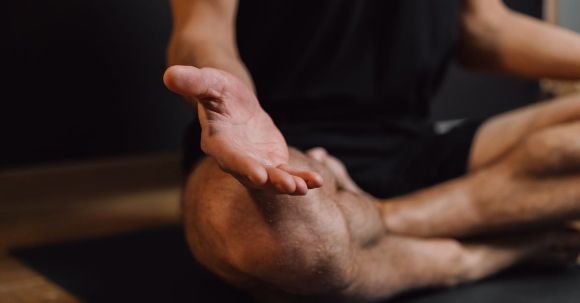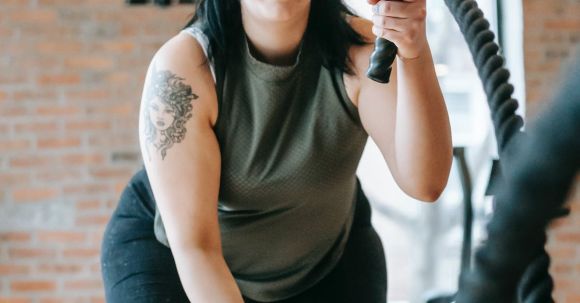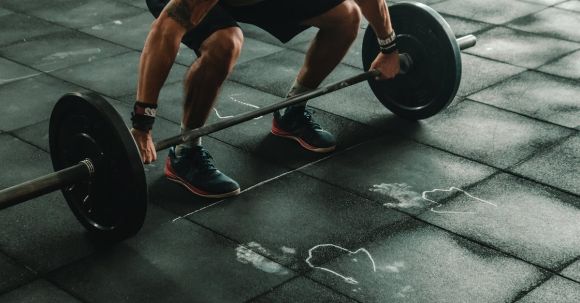Mastering a sport requires more than just physical fitness and strength. It involves honing your technique and skills to perform at your best. Sports-specific training is the key to achieving peak performance in any sport. By focusing on the specific demands and movements required for your chosen sport, you can fine-tune your technique and take your performance to the next level. In this article, we will explore the importance of sports-specific training and how you can incorporate it into your training routine.
Blog Posts
In today's fast-paced world, many people struggle to get a good night's sleep. Stress, anxiety, and a constant stream of thoughts can often keep us awake, tossing and turning. However, there are simple and effective ways to improve your sleep quality. Yoga and meditation, when practiced regularly, can help you relax, calm your mind, and achieve a more restful sleep. In this article, we will explore how these ancient practices can be integrated into your daily routine to promote better sleep.
Reducing Stress with Yoga
Stress is one of the main culprits behind sleepless nights. The physical and mental tension we accumulate throughout the day can make it challenging to unwind and fall asleep. Yoga, with its focus on deep breathing and gentle stretching, can be incredibly effective in reducing stress levels. Start with simple yoga poses that target areas of tension in your body. The child's pose, for example, gently stretches the back and shoulders, releasing tension and promoting relaxation. Combine this with slow and mindful breathing, focusing on each inhale and exhale, to further calm your nervous system. Another beneficial pose for stress relief is the legs-up-the-wall pose. Lie on your back with your legs resting vertically against a wall. This pose helps to reverse the blood flow and activate the relaxation response in your body. Stay in this position for a few minutes and allow your mind to let go of any worries or distractions.Calming the Mind with Meditation
A busy mind can be a major obstacle to falling asleep. Racing thoughts and constant mental chatter can keep us awake for hours. Meditation is a powerful tool that can help quiet the mind, promoting a state of calm and relaxation. Start by finding a quiet and comfortable space where you can sit or lie down. Close your eyes and bring your attention to your breath. Focus on the sensation of each inhale and exhale, letting go of any thoughts that arise. If your mind starts to wander, gently bring your attention back to your breath. Practice this for a few minutes each day, gradually increasing the duration as you become more comfortable. Body Scan Meditation is another effective technique for promoting relaxation and better sleep. Lie down in a comfortable position and bring your attention to different parts of your body, starting from your toes and moving up to your head. Notice any areas of tension or discomfort and consciously relax those muscles. This practice helps to release physical tension and brings a sense of calm to the entire body.Creating a Bedtime Routine
In addition to incorporating yoga and meditation into your daily routine, establishing a bedtime routine can significantly improve your sleep quality. Create a calming atmosphere in your bedroom by dimming the lights, playing soothing music, or using essential oils known for their relaxation properties, such as lavender. Avoid using electronic devices at least an hour before bed, as the blue light emitted from screens can interfere with your sleep-wake cycle. Instead, engage in activities that promote relaxation, such as reading a book, taking a warm bath, or practicing gentle stretches. Conclusion: Embrace the Power of Yoga and Meditation for a Good Night's Sleep By incorporating yoga and meditation into your daily routine and creating a bedtime ritual, you can enhance your sleep quality and wake up feeling refreshed and rejuvenated. These practices not only help to reduce stress and calm the mind but also promote overall well-being. So, take a deep breath, roll out your yoga mat, and let the power of yoga and meditation guide you to a peaceful night's sleep.
Cardiovascular exercise, often referred to as cardio, is an essential component of any fitness routine. Whether you're a seasoned athlete or just starting out on your fitness journey, it's important to measure the intensity of your cardio workouts to ensure that you are getting the most out of your efforts. By tracking your intensity levels, you can gauge your progress and make adjustments to your routine as needed. In this article, we will explore some effective methods for measuring the intensity of your cardio workouts.
Heart Rate Monitoring
One of the most reliable ways to measure the intensity of your cardio workouts is by monitoring your heart rate. This can be done using a heart rate monitor, which can either be worn on your wrist or chest. By keeping an eye on your heart rate during exercise, you can determine whether you are working within your target heart rate zone. This zone is typically defined as 50% to 85% of your maximum heart rate, which can be calculated by subtracting your age from 220.Perceived Exertion Scale
Another method for measuring the intensity of your cardio workouts is by using the perceived exertion scale. This scale is based on your subjective perception of how hard you feel you are working during exercise. It ranges from 1 to 10, with 1 being the easiest level of exertion and 10 being the most difficult. By paying attention to how your body feels during your workout, you can assign a number to your perceived exertion and use it as a guide to adjust the intensity of your cardio routine.Talk Test
The talk test is a simple yet effective way to measure the intensity of your cardio workouts. If you can carry on a conversation without much effort, then you may be working at a lower intensity level. On the other hand, if you are struggling to speak or catch your breath, it may indicate that you are working at a higher intensity level. By paying attention to your ability to talk during your workout, you can determine whether you need to push harder or ease up.Rate of Perceived Exertion
Similar to the perceived exertion scale, the rate of perceived exertion (RPE) is another method that relies on your subjective perception of effort. The RPE scale ranges from 6 to 20, with 6 being very, very light and 20 being an all-out maximum effort. By assigning a number to your perceived exertion, you can objectively measure the intensity of your cardio workouts and make adjustments accordingly.Tracking Distance or Speed
If you prefer a more quantitative approach, you can measure the intensity of your cardio workouts by tracking the distance you cover or your speed. For example, if you are running, you can use a GPS watch or smartphone app to track your distance and pace. By comparing your performance over time, you can see whether you are improving and adjust your intensity levels accordingly. This method is particularly useful for individuals who enjoy competitive sports or have specific goals related to speed or distance.Conclusion
Measuring the intensity of your cardio workouts is crucial for optimizing your fitness routine. By utilizing methods such as heart rate monitoring, the perceived exertion scale, the talk test, the rate of perceived exertion, or tracking distance or speed, you can ensure that you are working at an appropriate intensity level. Remember to listen to your body and make adjustments as needed to achieve your desired fitness goals.
Fueling your body with the right nutrients before and after a workout is essential for maximizing your performance and aiding in recovery. The food you choose to consume can have a significant impact on your energy levels, muscle growth, and overall fitness progress. In this article, we will explore the best options for pre and post-workout meals to help you get the most out of your exercise routine.
Pre-Workout Nutrition
Eating the right foods before a workout can provide you with the energy and stamina needed to power through your exercise session. Here are some key factors to consider when planning your pre-workout meal: Timing: It's important to eat a meal or snack containing carbohydrates and protein about 1 to 3 hours before you start exercising. This allows enough time for digestion and absorption of nutrients. Carbohydrates: Complex carbohydrates, such as whole grains, fruits, and vegetables, should form the basis of your pre-workout meal. They provide a steady release of energy and help prevent blood sugar crashes during exercise. Protein: Including a source of protein in your pre-workout meal can help to support muscle growth and repair. Opt for lean protein sources like chicken, fish, tofu, or Greek yogurt. Fats: While fats are an important part of a healthy diet, it's best to avoid consuming large amounts of fat before a workout. Fats take longer to digest and can cause discomfort during exercise. Hydration: Don't forget to drink enough water before your workout to stay hydrated. Aim to drink at least 8 ounces of water 30 minutes before exercising. Some pre-workout meal ideas include a whole-grain toast with peanut butter and banana, a chicken and vegetable stir-fry with brown rice, or a Greek yogurt with berries and a handful of nuts.Post-Workout Nutrition
After an intense workout, your body needs to replenish its energy stores and repair damaged muscle tissue. The right post-workout meal can help kickstart the recovery process and enhance muscle growth. Here are some considerations for your post-workout nutrition: Timing: It's crucial to consume a meal or snack within 30 minutes to 2 hours after exercising. This is when your muscles are most receptive to nutrient absorption. Protein: Including a high-quality protein source in your post-workout meal is essential for muscle repair and growth. Opt for options such as chicken breast, eggs, beans, or protein shakes. Carbohydrates: Consuming carbohydrates after a workout helps replenish glycogen stores, which are depleted during exercise. Choose complex carbs like sweet potatoes, quinoa, or whole-grain pasta. Fruits and Vegetables: Including a variety of fruits and vegetables in your post-workout meal provides essential vitamins, minerals, and antioxidants that aid in recovery and reduce muscle inflammation. Hydration: Rehydrating after a workout is crucial to replace fluids lost through sweat. Water is usually sufficient for most workouts, but if you engaged in intense exercise or experienced excessive sweating, consider a sports drink or coconut water to replenish electrolytes. Some post-workout meal ideas include a grilled chicken breast with roasted vegetables and quinoa, a spinach and fruit smoothie with added protein powder, or a salmon salad with mixed greens and sweet potato. In conclusion, paying attention to your pre and post-workout nutrition is vital for optimizing your exercise performance and recovery. By fueling your body with the right combination of carbohydrates, protein, and other essential nutrients, you can enhance your workout results and achieve your fitness goals more effectively. Remember to hydrate adequately and choose whole, nutritious foods to support your overall health and well-being.
In today's fast-paced world, finding time to exercise can be a challenge. Add to that the limited availability of gym equipment, and it can seem almost impossible to train for strength. However, with a little creativity and strategic planning, it is possible to build strength even with limited time and equipment. In this article, we will explore some effective strategies that will help you maximize your training sessions and make the most of the resources you have.
1. Focus on Compound Movements
When time and equipment are limited, it's crucial to prioritize exercises that target multiple muscle groups simultaneously. Compound movements, such as squats, deadlifts, bench presses, and pull-ups, are excellent choices. These exercises engage several muscle groups at once, allowing you to make the most of your training time. Incorporate these movements into your routine to build overall strength efficiently.2. Utilize Bodyweight Exercises
One of the best aspects of bodyweight exercises is that they require no equipment. They can be done anytime, anywhere, making them perfect for those with limited resources. Push-ups, lunges, planks, and burpees are just a few examples of bodyweight exercises that can help you improve strength and build muscle. Don't underestimate the effectiveness of these exercises. By focusing on proper form and gradually increasing the difficulty, you can achieve significant results.3. Implement High-Intensity Interval Training (HIIT)
HIIT is a training method that alternates between short bursts of intense exercise and brief recovery periods. This style of training is not only time-efficient but also highly effective for improving strength and cardiovascular fitness. Incorporate exercises like jump squats, mountain climbers, or kettlebell swings into your workouts and perform them in quick, intense intervals. Not only will this save you time, but it will also improve your overall strength and endurance.4. Maximize Training Density
Training density refers to the amount of work done in a given timeframe. When time is limited, increasing training density can help you accomplish more in a shorter period. To do this, reduce the rest periods between sets and exercises. By minimizing rest time, you keep your heart rate elevated and increase the intensity of your workout. This approach not only saves time but also helps improve strength and burn more calories.5. Incorporate Resistance Bands
Resistance bands are a versatile and affordable training tool that can provide an effective strength workout even with limited equipment. They come in different resistance levels, allowing you to progressively challenge your muscles. Resistance bands can be used for various exercises, such as bicep curls, shoulder presses, and lateral raises. They can also be attached to a door or anchor point to simulate cable machine exercises. By incorporating resistance bands into your routine, you can effectively target different muscle groups and continue to make strength gains.Conclusion: Train Smart, Not Long
While it may seem challenging to train for strength with limited time and equipment, it's important to remember that consistency and efficiency are key. By focusing on compound movements, utilizing bodyweight exercises, implementing HIIT, maximizing training density, and incorporating resistance bands, you can build strength even with limited resources. Remember, it's not about the quantity of time you spend training, but the quality of the exercises you perform. So, train smart, not long, and you'll be on your way to achieving your strength goals.
In today's fast-paced world, finding time for exercise can be a challenge. Between work, family, and other commitments, our schedules are often packed. However, it's important to prioritize our health and fitness, even when time is limited. Fortunately, there are quick and effective workouts that can be done in a short amount of time, allowing you to stay active and fit, no matter how busy you are.
1. HIIT (High-Intensity Interval Training)
HIIT workouts are perfect for busy individuals who want to maximize their workout in a short amount of time. This type of training involves short bursts of intense exercise followed by brief periods of rest. The high-intensity intervals get your heart rate up and burn calories, while the rest periods give you a chance to recover. HIIT workouts can be done in as little as 20 minutes and can be tailored to your fitness level and preferences.2. Tabata Training
Similar to HIIT, Tabata training is a form of high-intensity interval training that follows a specific structure. It consists of 20 seconds of all-out effort followed by 10 seconds of rest, repeated for a total of four minutes. This short but intense workout can be done with various exercises, such as squats, push-ups, or burpees. Tabata training is a quick and efficient way to improve cardiovascular fitness and build muscle strength.3. Circuit Training
Circuit training is a versatile workout that combines strength and cardiovascular exercises into a series of stations. You move quickly from one exercise to the next, with little to no rest in between. This type of workout can be customized to target specific muscle groups or overall body conditioning. Circuit training is time-efficient, as it allows you to work multiple muscle groups simultaneously and keeps your heart rate elevated throughout the workout.4. Bodyweight Exercises
Bodyweight exercises are an excellent option for busy schedules, as they require no equipment and can be done anywhere. These exercises use your own body weight as resistance, making them effective for building strength and endurance. Push-ups, squats, lunges, planks, and burpees are just a few examples of bodyweight exercises that target multiple muscle groups. You can create a quick and effective workout by combining different bodyweight exercises and performing them in a circuit or interval format.5. Mini Workouts Throughout the Day
If finding a dedicated block of time for exercise is a challenge, consider incorporating mini workouts into your daily routine. These short bursts of activity can add up throughout the day and provide numerous health benefits. For example, you can do a set of squats while waiting for your coffee to brew or take the stairs instead of the elevator. Even a few minutes of exercise here and there can make a difference in your fitness level and overall well-being.Conclusion: Prioritize Your Health
Although it may seem difficult to fit exercise into a busy schedule, it's essential to prioritize your health and make time for physical activity. Quick and effective workouts, such as HIIT, Tabata training, circuit training, and bodyweight exercises, can help you stay active and fit even when time is limited. Additionally, incorporating mini workouts throughout the day can provide numerous health benefits. With a little creativity and determination, you can find ways to stay active and maintain a healthy lifestyle, no matter how busy you are.
In today's fast-paced world, it's easy to get caught up in the chaos of daily life. We often find ourselves constantly multitasking, thinking about the past or worrying about the future. This lack of presence can lead to stress, anxiety, and a general feeling of being disconnected from ourselves and those around us. However, by incorporating yoga and meditation into our daily routine, we can cultivate mindfulness and presence, allowing us to live more fully in the present moment.
The Power of Yoga
Yoga is a practice that combines physical postures, breath control, and meditation. It has been practiced for thousands of years and has numerous benefits for both the body and mind. One of the primary goals of yoga is to bring the practitioner into a state of mindfulness and presence. Through the practice of yoga, we learn to focus on our breath and the sensations in our body. We become aware of our thoughts and emotions without judgment or attachment. This awareness allows us to let go of the past and future, and be fully present in the moment. By regularly practicing yoga, we can train our minds to be more present and focused. This can have a profound impact on our overall well-being, as we become more attuned to our bodies and more aware of our thoughts and emotions.The Benefits of Meditation
Meditation is another powerful tool for cultivating mindfulness and presence. It involves training the mind to focus on a single point of awareness, such as the breath, a mantra, or a visual object. Through consistent practice, we can develop a greater sense of calm and clarity. Meditation has been scientifically proven to reduce stress, anxiety, and depression. It also improves concentration, enhances creativity, and promotes a sense of overall well-being. By regularly practicing meditation, we can become more present in our daily lives, leading to greater happiness and fulfillment.Integrating Yoga and Meditation
While yoga and meditation are powerful practices on their own, they are even more effective when combined. By integrating yoga and meditation, we can deepen our mindfulness and presence. Start by incorporating a few minutes of meditation into your yoga practice. After completing your physical postures, find a comfortable seated position and focus on your breath. Notice the sensations in your body and the thoughts that arise. Simply observe them without judgment, and gently bring your attention back to your breath whenever you become distracted. Over time, you can gradually increase the duration of your meditation practice. Set aside a specific time each day to sit in meditation, even if it's just for a few minutes. As you continue to cultivate mindfulness and presence through yoga and meditation, you'll begin to experience the benefits in all areas of your life.Conclusion: Embrace the Present Moment
In a world that often feels chaotic and overwhelming, it's important to cultivate mindfulness and presence. By incorporating yoga and meditation into our daily routine, we can train our minds to be more present and focused. This allows us to fully embrace the present moment and live more fully in each experience. So, make a commitment to yourself today. Set aside time each day for yoga and meditation. Notice how these practices enhance your ability to be present and fully engaged in your life. Embrace the power of mindfulness and presence, and watch as your overall well-being flourishes.
Negative thoughts and emotions can be overwhelming and can have a significant impact on our overall well-being. They can consume our minds, drain our energy, and hinder our ability to live a happy and fulfilled life. However, there is a powerful tool that can help us overcome these negative thoughts and emotions - meditation.
Understanding Negative Thoughts and Emotions
Before we delve into how meditation can help us overcome negative thoughts and emotions, let's first understand what they are. Negative thoughts are those pesky little voices in our heads that constantly criticize, doubt, and judge ourselves and others. They can be self-sabotaging and can lead to feelings of anxiety, sadness, and anger. Emotions, on the other hand, are the physiological and psychological responses to our thoughts. They can range from mild irritation to intense anger, from sadness to despair. Negative emotions can be triggered by a variety of factors such as past traumas, stressful events, or even our own thoughts and beliefs.The Power of Meditation
Meditation is a practice that has been around for centuries and has been used by people from various cultures and backgrounds to achieve a sense of calm and inner peace. It is a simple yet powerful technique that involves focusing our attention and quieting the mind. By practicing meditation regularly, we can train our minds to become more aware of our thoughts and emotions. This heightened awareness allows us to observe our negative thoughts and emotions without getting caught up in them. We become like a silent observer, detached from the constant chatter of our minds.Cultivating Positive States of Mind
One of the main benefits of meditation is its ability to help us cultivate positive states of mind. Through meditation, we can develop qualities such as compassion, patience, and gratitude. These positive states of mind can counteract the negative thoughts and emotions that often plague us. By focusing on positive thoughts and emotions during meditation, we can rewire our brains and create new neural pathways. This can lead to a shift in our mindset, making us more resilient in the face of negative thoughts and emotions.Letting Go of Attachments
Another way meditation can help us overcome negative thoughts and emotions is by teaching us to let go of attachments. Often, our negative thoughts and emotions are fueled by our attachment to certain outcomes or beliefs. We become so invested in our thoughts and emotions that we lose sight of the present moment. Through meditation, we can learn to let go of these attachments and embrace the present moment as it is. We can detach ourselves from our negative thoughts and emotions and realize that they are transient and impermanent. This realization can bring a sense of freedom and lightness to our lives.Finding Inner Peace
Ultimately, the goal of meditation is to find inner peace. By regularly practicing meditation, we can create a space within ourselves that is calm, serene, and unaffected by the ups and downs of life. This inner peace can act as a shield against negative thoughts and emotions, allowing us to navigate through life with grace and resilience.Conclusion: Embracing the Power of Meditation
Negative thoughts and emotions are a part of life, but they do not have to control us. By embracing the power of meditation, we can overcome these negative thoughts and emotions and live a more peaceful and fulfilling life. So, why not start your meditation practice today and experience the transformative effects it can have on your well-being?
Functional strength training has gained popularity in recent years as an effective way to improve overall strength, mobility, and performance in daily activities. Unlike traditional strength training that focuses on isolated muscle groups, functional strength training emphasizes movements that mimic real-life activities. Whether you are a beginner or have some experience with strength training, this guide will provide you with the essential information to get started with functional strength training.
Understanding Functional Strength Training
Functional strength training is all about improving your ability to perform everyday movements with ease and efficiency. It focuses on developing functional muscle strength, which means training your muscles to work together to perform specific tasks rather than isolating individual muscles.Benefits of Functional Strength Training
1. Improved Performance: Functional strength training enhances your ability to perform activities such as lifting, carrying, pushing, and pulling. By targeting multiple muscle groups, it improves your overall strength and power. 2. Increased Stability and Balance: Functional exercises engage the core muscles, helping to improve stability and balance. This is particularly beneficial for older adults, as it reduces the risk of falls and injuries. 3. Enhanced Joint Health: By training multiple muscle groups simultaneously, functional strength training helps to promote joint stability and mobility. This can alleviate joint pain and reduce the risk of injuries.Getting Started
Before beginning any exercise program, it is important to consult with a healthcare professional, especially if you have any pre-existing conditions or injuries. Once you have the green light, follow these steps to start your functional strength training journey: 1. Set Clear Goals: Determine what you hope to achieve through functional strength training. Whether it's improving your overall fitness, increasing your strength, or enhancing your athletic performance, having clear goals will help you stay motivated and focused. 2. Learn the Basics: Familiarize yourself with the foundational movements of functional strength training. These include squats, lunges, pushes, pulls, and rotational exercises. Start with bodyweight exercises before progressing to using weights or resistance bands. 3. Focus on Proper Form: Proper form is crucial in functional strength training to prevent injuries and ensure effective muscle engagement. Take the time to learn and practice the correct technique for each exercise. If needed, seek guidance from a qualified fitness professional. 4. Start Slow and Progress Gradually: Begin with lighter weights or resistance bands and gradually increase the intensity and difficulty of your workouts. This allows your muscles and joints to adapt and reduces the risk of overexertion or injury.Sample Functional Strength Training Workout
Warm-Up: - Jog or brisk walk for 5-10 minutes to increase your heart rate and warm up your muscles. Workout:1. Squats: 3 sets of 10 reps
2. Push-Ups: 3 sets of 10 reps
3. Lunges: 3 sets of 10 reps per leg
4. Bent-Over Rows: 3 sets of 10 reps
5. Plank: Hold for 30 seconds, repeat 3 times
6. Russian Twists: 3 sets of 10 reps per side
Cool-Down: - Stretch your major muscle groups, holding each stretch for 15-30 seconds. Incorporating functional strength training into your fitness routine can have numerous benefits. Remember to listen to your body, rest when needed, and gradually progress your workouts. Consistency is key, so aim for at least two to three sessions per week.Conclusion: Embrace Functional Strength Training
Functional strength training is a versatile and effective way to improve your overall strength, mobility, and performance in daily activities. By focusing on movements that mimic real-life tasks, you can enhance your functional muscle strength and enjoy the benefits of improved performance, stability, and joint health. Remember to start slow, focus on proper form, and gradually progress your workouts. With consistency and dedication, functional strength training can help you achieve your fitness goals and live a more functional life.
Maintaining good posture is essential for overall health and well-being. Poor posture can lead to various health issues, such as back pain, muscle imbalances, and reduced flexibility. Many people are now turning to strength training as a way to improve their posture. But can strength training really make a difference? In this article, we will explore the potential benefits of strength training for improving posture.









